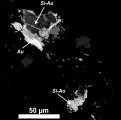A new type of gold mineralization discovered in the Bohemian Massif
Gold deposits of economic importance can be found in the Bohemian Massif (e.g., Mokrsko or Kašperské Hory). These well known occurrences are intimately associated with magmatic/hydrothermal processes during the Variscan orogeny (at ca. 340 Ma). A new study co-authored by Institute scientists Lukáš Ackerman and Martin Svojtka describes a completely new type of gold mineralization found in shales of Neoproterozoic age (ca. 570 Ma). Structural position of quartz veinlets that host gold mineralization together with the chemistry of the associated sulphides link this type of gold mineralization with high heat flow in response to continental rifting during the Ordovician (c. 470 Ma). The discovery is not of economic significance but represents a new genetic model for this type of gold mineralization in the Bohemian Massif. For additional information, see Mineralium Deposita journal.


